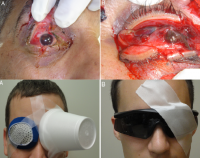03/09/2014
Ne comprimez pas les yeux
The use of rigid eye shields (Fox shields) at the point of injury for ocular trauma in Afghanistan
Mazolli RA et Al. J Trauma Acute Care Surg. 2014;77: S156-S162
BACKGROUND:
Unlike hemorrhagic injuries in which direct pressure is indicated, any pressure placed on the eye after penetrating trauma can significantly worsen the injury by expulsing intraocular contents. The accepted first response measure for obvious or suspected penetrating ocular injury is placement of a rigid shield that vaults the eye so as to prevent accidental iatrogenic aggravation during transport to the ophthalmologist. Patching and placing intervening gauze between the shield and the eye are both contraindicated.

Anecdotally, compliance with these recommendations is poor in the military and civilian communities alike; however, published studies documenting compliance are uniformly lacking. This study was undertaken to provide such an evaluation.
METHODS:
In this retrospective observational study, the Department of Defense Trauma Registry was reviewed to identify eye injuries in Afghanistan from 2010 to 2012 and to examine compliance with eye shield recommendations. One hundred fifty-seven records of eye casualties were identified and categorized according to diagnostic codes, noting use of a shield. A subset of 30 records was further analyzed for compliance with other core treatment measures specified by the operant Clinical Practice Guideline. Because comparative studies do not exist, simple statistical analysis was performed.
RESULTS:
Overall, 39% of eye injuries received a shield at the point of injury (61% failure), ranging from 0% to 50% between diagnostic subgroups. Subset analysis revealed that only 4.2% of injuries were successfully mitigated at the point of injury (95.8% failure).
CONCLUSION:
In one of the few studies documenting the use of eye shields after ocular trauma, anecdotal reports of poor, inadequate, or incorrect compliance with basic recommendations were substantiated. Several factors may account for these findings. Corrective efforts should include enhanced educational emphasis and increased shield availability.

Les commentaires sont fermés.